Commodore 264
Introduction
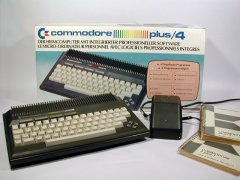 The Commodore 264 is not actually a computer but it's a model range. This range of computers consist of the C16, C116, Plus/4 and the prototypes 232, 264 and the 364.
The Commodore 264 is not actually a computer but it's a model range. This range of computers consist of the C16, C116, Plus/4 and the prototypes 232, 264 and the 364.The name 264 was used for the first proto type of this range and is printed on most of the serial tags at the bottom of the computers. After the success of the Commodore 64 and the end of the VIC 20 production it was time to develop a new computer range.
The exact reasons for the 264 range are not clear. Some sources say that it was the successor of the VIC20. But there are also sources that tell that is was intended to compete with the Sinclair Spectrum or Timex as it was called in the USA. And if you take a look at the C116 that you will see similarities with the Spectrum. The target was to build a cheap computer like the C116 and the C16 with above that the advanced version with bigger memory and build in programs like the Plus/4. The proto type 364 was a Plus/4 with a bigger keyboard and a processor that could produce spoken words. The 264 series was also a attempt to get into the professional market. This was the main task of the Plus/4 with build in programs like a word processor, spreadsheet, database and a graphical program. The strange thing is that all the three models (C16, C116 and the Plus 4) use a different motherboard.
Specifications
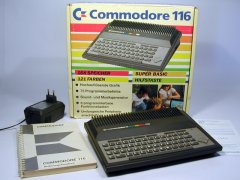 Processor: MOS 7501 / MOS 8501, 1.8 (0,9) MHz.
Processor: MOS 7501 / MOS 8501, 1.8 (0,9) MHz.RAM memory: 64 kbyte
ROM memory: 64 kbyte (Basic, Kernal, Characters, TEDMon, Programs)
Co-Processor Graphic / Sound: TED
Connections: Expansion-port, User-port, Serial-port, Datassette, 2 x Joystick, TV, Video, Audio, Power-Supply.
Remark:
The specifications above are for the Plus/4. The C116 and the C16 only have 16 kbyte of RAM and 20 kbyte of ROM. And there is no User port on these models.On the picture a C116. This is a PAL version. The C116 is the little brother of the Plus/4 with less memory and no build in programs. The outside looks like the Plus/4 but is a smaller. The keyboard was a attempt to reduce the price of the computer. The keyboard is as bad as that of the Max machine.
The use.
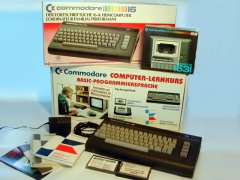 Commodore introduced the 264 as a professional machine to be used by companies and schools. But as it was with the VIC 20 and the C64 games was the most attractive use of the machine. The 264 was not as good at games as the C64. The sales of this series never reached a level like that of the C64. Problem was that the C64 stayed in production when the 264 went in production. The C64 was too big of a competitor for the 264 range. In Europe a large amount of the C16 and the Plus/4 computers were sold as a package. The package consisted of a computer, datassette, and a complete BASIC course and a couple of other games or programs.
Commodore introduced the 264 as a professional machine to be used by companies and schools. But as it was with the VIC 20 and the C64 games was the most attractive use of the machine. The 264 was not as good at games as the C64. The sales of this series never reached a level like that of the C64. Problem was that the C64 stayed in production when the 264 went in production. The C64 was too big of a competitor for the 264 range. In Europe a large amount of the C16 and the Plus/4 computers were sold as a package. The package consisted of a computer, datassette, and a complete BASIC course and a couple of other games or programs.For this series a new range of external devices was introduced. Like the MPS 803 printer in black. There was a special disk drive for the 264 series, this was the 1551. The 1551 looks like a black painted version of the 1541 but has a parallel connection instead of a serial connection. Buying a joystick was not that easy. For a not explained reason Commodore decided to get ride of the standard connection for a joystick and put a new type of connector on this model range (mini DIN). Most people got an adapter cable which made it possible to connect normal sub-D 9 joysticks to the new type of connector.
Off course you could go to Commodore Computer meetings but they where mostly C64 orientated.
Games:
In spite of the poorer game possibilities of the 264 series in comparison with the C64 many games were written for this computer. Because the C116 and the C16 have less memory not all games could be played on these machines. Some of the well known games are: Quadrilion, Winter / Summer events, Jerry's Quest, Dizzy, David's Midnight Magic, Elite, Ace.Graphic programs:
The 264 series has a bigger color pallet than earlier Commodore computers. The amount of colors is 16. And every color has 8 levels of brightness what will bring the total number of colors to 121 different colors. (A number of colors are not counted because they are the same). Well known graphic programs are: (Multi) Botticelli, MagicPaint +++, FLI Editor, Micro Illustrator, Graphics.Music programs:
The 264 series has a music chip which is a bit less advanced then the SID chip in the C64 but can produce reasonable sound. Well known music programs are: MConv v1.6, Music-Hearing V1.0, Speech +4, Digital Drum Machine, RAP4.Word processors:
The Plus/4 has a word processor build in but there was also other software available. Well known word processors are: Script/Plus, Page Setter and the word processor in GEOS 3.5.Office package:
The most known and used package is GEOS. GEOS is a complete package for the Plus/4 or a RAM expanded C116 and C16's in combination with a 1551 disk drive. Build in disk speeder, word processor, database, graphic program, communications and much more. Besides GEOS there are also other programs like: Calc/Plus, Superbase +4, Script/Plus.Utilities:
For specific tasks are special programs available. Copy programs for the Datassette and Disk drive are made in many versions. Also crunchers (zip) are popular to reduce the size of programs making loading faster. A few examples of utilities: Mega Assembler, Disk Demon, Austrospeed Compiler, Cruel Crunch 4.0, Dir-god V3.3.Demos:
Demos started as a sort of competition between hackers. Hackers included a little intro before the cracked program. In the beginning it was a text scroll soon followed by a couple of hires pictures. Some cracked games were copied just because of the intro and not the game. After a while the intros became stand alone programs (demos) that showed everything that was possible with a C16, C116 or a Plus/4 and also the stuff that was not possible. Nowadays the making of a demo is a art and the most demos fill two sides of a disk. Some of the best demos are: Chaos (Absence), Questionmark (New System Technology (NST)), Infinity (Electronic Vision Software (EVS)), Heartfixer (Luca and Bubis), Genetic Faulty (Gentlemen Software (GS)), We are the cure (Luca and Bubis). Hundreds of demos are made and you can find web sites that will host these demos.Cartridges:
Not a lot of cartridges were made for the 264 series. The production of cartridges was expensive and they were easy to crack. Cartridges went out of fashion for these reasons. A few examples are: Jack Attack, Pirate Adventure, Script Plus, Calc Plus, C16 Tutor. Also a memory expansion and a SID cartridge are available.External devices:
For this range of computers is also a range a external devices available. Most known and sold must be the black edition of the 1530 datassette the 1531. Except for the color and the connector it is equal to the 1530. With a little adapter you can use a 1531 with a VIC-20 or a C64. There is a 1551 disk drive that looks like the 1541 but it has a parallel connection for faster loading and saving data. The MPS 803 printer is available in the black color. Commodore also offered a joystick. The Commodore joysticks were not that good so most people bought another brand. You had to use a adapter cable to connect another joystick.On the picture a C16 "Lernkurs" package. This package consist of a C16 with a datassette and a BASIC course on cassette with a book. This package was available in the German and English language.
The Central Processing Unit 7501 (8501).
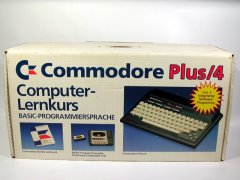 The processing power of the C16, C116 and the Plus/4 is taken care of by the 7501 (8501). The 7501 and the 8501 are identical in technical way. The only difference is the way they were produced.
The processing power of the C16, C116 and the Plus/4 is taken care of by the 7501 (8501). The 7501 and the 8501 are identical in technical way. The only difference is the way they were produced.Technical specifications:
Data bus: 8 bitsAddress bus: 16 bits
I/O bus: 7 bit
Interrupts: IRQ, RDY
Speed: 1,8 or 0,9 MHz
Instructions: 150
Data bus:
The 7501 (8501) works like all other processors with the binary system. That means there are only 2 possibilities on or off. This will be shown as a 0 or a 1. This called a bit. If you got a 8 bit wide data bus then the possibilities are 00000000 to 11111111. A value of 8 bit wide is called a byte. In the normal decimal system that is 0 to 255. All processing is limited to the numbers 0 to 255. If you need bigger numbers you will have to chop the big number into little parts.Address bus:
With the address bus the processor can point to a point (address) in the memory. The limitation is the width of the bus. With 16 bits you can make a numbers between 00000000 00000000 and 11111111 11111111. Or in decimals between 0 and 65536. The 7501 (8501) can address 64 kbyte of memory. But there are memory expansion that will go to 256 kbyte and more. If you want to address more than 64 kbyte you have to switch between memory banks (bank-switching). This trick has also been used in the PET / CBM range and the C128. The processor can only see 64 kbyte at one time.I/O bus:
This part is extra with the 7501 (8501) in comparison to the 6502 processor (PET/CBM, VIC20). And this was also put in the C64. This I/O bus can change how the C16, C116 and the Plus/4 looks inside. The bus is 7 bit wide and will give 128 options in theory. The data on this bus is connected to the PLA which does the switching of memory inside of the C16, C116 and the Plus/4. The C16, C116 or the Plus/4 is a 64 kbyte machine but in reality there is 64 kbyte RAM, 8 kbyte KERNAL, 8 kbyte BASIC, 4 kbyte characters, 2 x 8 kbyte for cartridges, Registers of the TED. Normally this will not fit in a 64 kbyte system but with clever switching you can use everything only not at the same time. If you use BASIC the RAM under the BASIC cannot be used this explains the boot message of the Plus/4 - 60671 BASIC BYTES FREE. But if you don't need the BASIC you simply switch it off and you can use the RAM memory underneath it.Interrupts:
A interrupt is a stop-sign. The processor can be halted with a interrupt. If the TED needs more time it will halt the processor via a interrupt.Speed:
The system speed of the C16, C116 or the Plus/4 is 1,8 MHz (or 0,9 MHz). This means that there are 1,8 (or 0,9) million actions per second that are processed. So the 7501 (8501) processor can do 1.800.000 (of 900.00) action every second. The fasted instruction takes only 2 actions but the slowest instruction takes 7.On which speed the processor works depends on what the TED is doing. If the screen is made or the RAM is refreshed the speed will be switched to the lower speed. In other cases the higher speed will be available.
Instructions:
The number of instructions is 150 but there are in theory 255 instruction possible. Programmers found extra instruction by experimenting. But these are actually defects that are build into the chips and are not real instructions. There are instructions that only move data like LDA (Load the accumulator with a value) but there are also instructions that will calculate data like ADD (ADD a value to the accumulator) Also there are instructions the manipulate a value like ROR which shifts the bits a place to the right.On the picture a Plus/4 "Lernkurs". This package consist of a Plus/4 with a datassette and a BASIC course on cassette with a book. This package was available in the German and English language.
The TED.
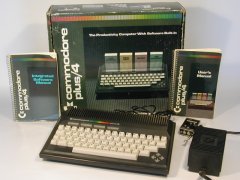 TED stands for Text EDitor and takes care of the graphic on the screen produces the sound gets the keyboard information keeps track of time and manages the memory. Al these tasks are normally done by more than 1 chip like in the C64. Combining all these parts resulted in a cheap computer. But combining all these tasks meant that there had to be some limitations on the possibilities of the computer. This is what became the weak point of the 264 series. Like other Commodore models the TED is compatible with the television standard and different versions were produced.
TED stands for Text EDitor and takes care of the graphic on the screen produces the sound gets the keyboard information keeps track of time and manages the memory. Al these tasks are normally done by more than 1 chip like in the C64. Combining all these parts resulted in a cheap computer. But combining all these tasks meant that there had to be some limitations on the possibilities of the computer. This is what became the weak point of the 264 series. Like other Commodore models the TED is compatible with the television standard and different versions were produced.7380 / 8360 - PAL-B (Europe, Africa, Asia, Australia) and NTSC (North America, South America, Japan)
8365 - PAL-N (Argentina, Uruguay)
8366 - PAL-M (Brazil)
The 7380 and the 8360 are identical in technical way. The only difference is the way they were produced.
Technical specifications:
Text: 40 x 25 characters with 8 x 8 pixelsHires: 320 x 200 pixels, Multicolor: 160 x 200 pixels
Colors: 121
Smooth scrolling
Light pen
Hardware-cursor, -text blinking, -text reverse
Sound: 2 voices square shape. 1 Voice can produce noise
Volume control
Timers
Keyboard
A big disappointment of the TED was that it had no hardware sprites like on the C64 and the Amiga's
Text:
On the screen you can put 1000 characters. The character will come from the CHAR ROM but you can design your own characters. In normal text mode there are only two colors, the background color and the character color. But there is also a multicolor mode. In multicolor mode you can have 4 different colors but this will reduce the resolution from 8 x 8 pixels to 4 x 8 pixels.Hires:
Instead of characters the screen can now be filed with 320 x 200 = 64000 pixels. The drawback is that this will use up a large part of the memory (8 kbyte). Hires has also a multicolor mode and will reduce the resolution to 160 x 200 = 32000 pixels.Colors:
There are 16 different colors. Every color has also 8 levels of brightness. If you count all the colors you will come to 8 x 16 = 128 but the 8 brightness levels of black are all the same. So there are 128 - 7 = 121 different colors.Smooth scrolling:
The TED can move the complete screen with one pixel at the time in all directions (smooth scrolling). To let something appear from nothing the visible screen can be made smaller. The smaller screen is now 38 x 23 characters. Now you can place your data, characters or hires, in the covered part of the screen and slide it into the visible part of the screen. You can slide 8 pixels with smooth scrolling. If you need to slide more you have to move the whole screen data 8 pixels and start the sliding again from the start.Light pen:
If you shoot or click on the screen with a "light-gun" of "light-pen" the TED will tell you the position on the screen.Hardware-cursor, -textblinking, -textreverse:
The TED can put the cursor where you want with its hardware. The hardware can make all or some characters blink. A lot of character sets have build in reverse characters. The TED does the reverse via it's hardware.Sound:
The TED has two oscillators. A oscillator is a mechanism to produce a signal with a specific frequency. The oscillators inside the TED have a frequency range of about 100Hz tot 23kHz. The frequency can be adjusted in 1016 steps. The oscillators are independent of each other. The oscillators are also called voices. The shape of the signal produces by the oscillators is a square shape.Volume control:
The volume of the TED can be adjusted in 9 steps. (0-8)Timers:
With a timer you can make a signal with a specific timing. This is used to make a RS-232 signal.Keyboard:
The reading of the keyboard is also a task of the TED. It reads via a matrix which key is pressed on the keyboard.On the picture the NTSC version of the Plus/4. The only difference between the NTSC and the PAL version is a different frequency cristal. The video chip (TED) will adapt automatically to the chosen frequency. Besides the technical difference the packaging is also different to the PAL version.
The ROMs.
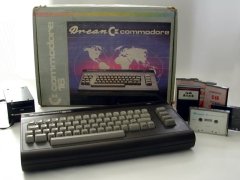 Inside the C16, C116 and the Plus/4 there are a couple of ROM's. These are memory modules with data inside that cannot be changed. You can read the memory but not write to this memory.
Inside the C16, C116 and the Plus/4 there are a couple of ROM's. These are memory modules with data inside that cannot be changed. You can read the memory but not write to this memory.KERNAL:
Most important ROM is the KERNAL ($D800-$D7FFF - 8 kbyte). The kernal is the operating system of the computer. Inside the kernal are the parts that let you load and save programs to the disk drive and the datassette or print text to the screen or printer.BASIC:
Another ROM is the BASIC ($8000-$9FFF - 8 kbyte). This contains the BASIC interpreter. The BASIC interpreter translates the BASIC commands to machine language. Machine language is the only language that the processor of the C16, C116 and the Plus/4 understands.CHAR:
The characters on the screen are coming from the CHARacter ROM. ($D800- $DFFFF - 4 kbyte)PLA:
The PLA looks like a ROM and can be replaced by a (very fast) EPROM but is actually a special designed switch. This switch controls the inside of the 16, C116 and the Plus/4.Plus4 programs:
In the Plus/4 there are a couple extra ROMs. Inside these ROMs there are user programs stored. The programs are a word processor, spreadsheet, database and a graphical program. The build in programs were to big for the available memory and the programs were adapted. The result was that the programs were not that good.On the picture a Drean C16. Drean was a Argentinean company that had it's own version of the C16 (also other Commodore models) that were sold in Argentina. The reason for this version was the high import taxes on complete computer systems. The motherboards came from Commodore and the rest was made in Argentina like the power supply, housing, packaging etc.
The connectors.
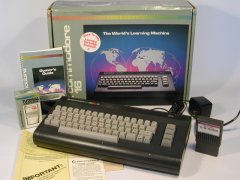 The C16, C116 and the Plus/4 have many connectors. All have a different function but are not always needed for an application. Only the Plus/4 had a user port.
The C16, C116 and the Plus/4 have many connectors. All have a different function but are not always needed for an application. Only the Plus/4 had a user port.User-port:
The user-port can be used to connect external devices to the Plus/4 to control or measure something. Examples are: Modems, Parallel printers, Parallel disk drives, relays, robots, EPROM programmers and much more. Nice thing about the user-port lines is that can be inputs or outputs independent from each other.Datassette:
The Datassette is the cassette recorder input of the C16, C116 and the Plus/4. Diskdrives where quite expensive and that was the reason that many computers had a cassette recorder connection. With the Commodore computers this was not a normal cassette recorder. Because all datassettes were equal there were very few problems with the loading of software. But the read / write head had to be in the right position. The use of cassettes was very popular after the introduction of the tape-turbos. Cassette software could be loaded faster than with a standard disk drive.IEC:
The IEC-port is a serial connection to devices like a disk drive or a printer. De serial-port was limited in speed.Video:
Via the video-bus the picture signal was send to a monitor. Also the audio was available through this bus. With the video connection and a monitor you had a better quality picture than through the RF.RF:
This is also the video and audio signal but now suited for a television-set.Expansion-port:
The expansion-port can be used to expand the C16, C116 and the Plus/4. The lines on this connector are connected to the de address- and databus. The most common use is to connect ROM's. ROM's contain programs that are permanently stored in a chip and are always and directly available. Many ROM's contained arcade games or utilities such as speedloaders, assemblers ect. The 1551 disk drive uses this connection to send or receive data much faster than a serial disk drive. Another group of expansions were memory expansions that gave the C16, C116 and the Plus/4 up to 256 kbyte (and more) of memory.Power-Supply:
Off course the C16, C116 and the Plus/4 needs power to make it's electronic parts work. The power supply delivers 5 volt DC for the IC's and 9 volt AC. The 9 volt AC is available at the user-port. Because the C16 and the C116 don't have a userport the 9 volt AC is not needed. These models have a different power supply.Joystick:
This must be the most important connector. The joystick was the key to play the many arcade games. This connection also connected the light-pen the paddles and the mouse.On the picture the NTSC version of the C16. This edition was sold with a tutor cartridge.
De 264 model range.

264 - 1983
Proto type of the 264 range. Was later renamed the Plus/4 and was taken into production.Plus/4 - 1984
Most expanded version of the 264 range with build in software.+/4 - 1984
Identical to the Plus/4 but with a wrong logo. The logo was changed.C16 - 1984
The successor of the VIC-20 with a cheaper motherboard (no userport or build in software).C116 - 1984
The competitor for the (Timex) Sinclair Spectrum. It has the same bad keyboard as the (Timex) Sinclair Spectrum.232 - 1984
Prototype, looks like the 264 but with less memory (32 kbyte). (about 200 were made)364 - 1985
Prototype, looks like the 264 but with a speech module and a bigger keyboard. (1 working prototype and 2 show models)Drean C16 - 1984
Drean was a Argentinean company that had it own version of the C16 (also other Commodore models) that were sold in Argentina. The reason for this version was the high import taxes on complete computer systems.On the picture the +4. It's a special edition with a different logo.
Update: 2011-11-26 16:30:31